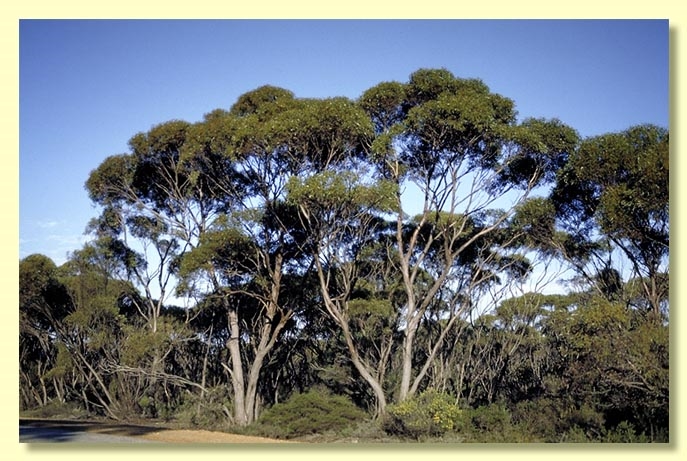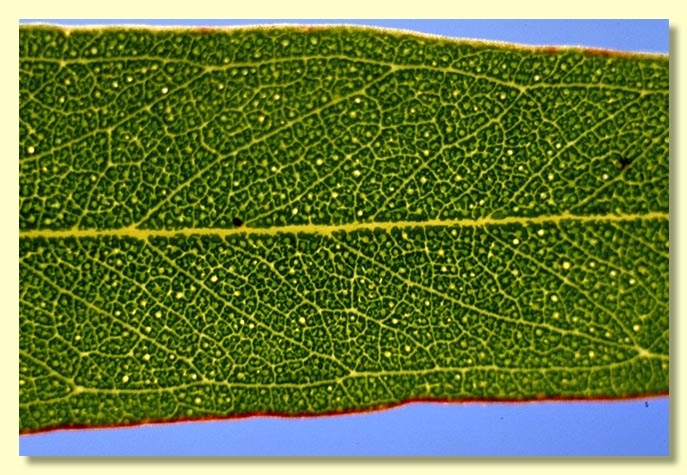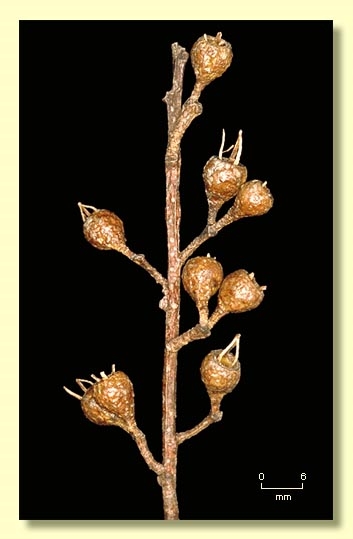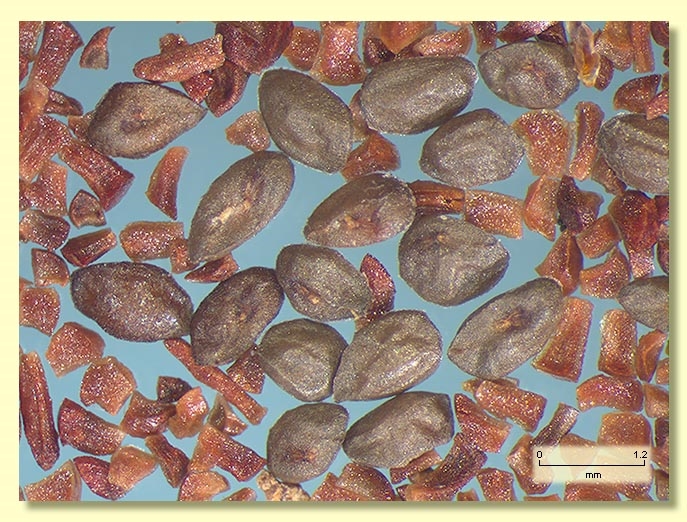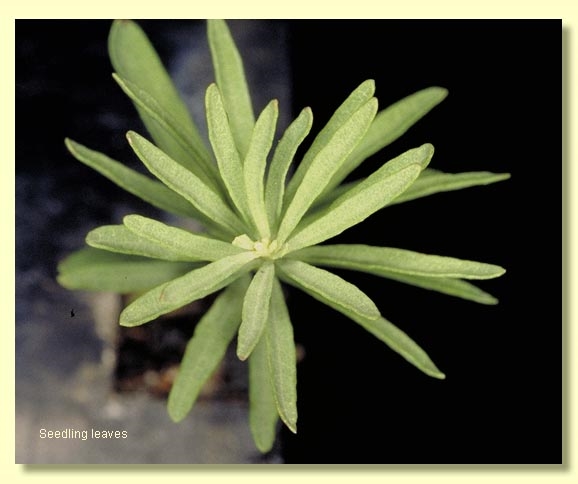Eucalyptus | Symphyomyrtus | Bisectae | Destitutae | Subulatae | Spirales
Euclid - Online edition
Eucalyptus oleosa subsp. corvina
T: Western Australia: 9 km W of Ravensthorpe to Hopetoun road on road 11, a mining access track (33° 41' S, 120° 05' E), 9 Oct. 1986, K.D.Hill 2374, L.A.S.Johnson, D. F.Blaxell & M.I.H.Brooker; holo: NSW; iso: PERTH.
Bark rough on the lower stem only, fibrous, flaky, grey to grey-brown, smooth bark grey over salmon-pink or coppery.
Branchlets lacking oil glands in the pith.
Juvenile growth (coppice or field seedlings to 50 cm): with round stems; juvenile leaves shortly petiolate, spirally arranged, 4–7 cm long, 1–1.6 cm wide, elliptical to oblong, dull grey-green.
Adult leaves alternate, petioles 0.8–1.7 cm; blade narrowly lanceolate to lanceolate, 5.5–11 cm long, 0.7–1.9 cm wide, base tapering to the petiole, margin entire, glossy green, side-veins acute, usually less than 45° to the midrib, rarely greater, reticulation moderate to dense, sometimes obscured by numerous intersectional oil glands, intramarginal vein present but can also be obscured by the oil glands.
Inflorescence axillary unbranched, peduncles erect, 0.5–1 cm long, buds usually more than 7, pedicellate, pedicels 0.3–0.5 cm long. Mature buds ovoid (0.6–1.1 cm long, 0.3–0.4 cm wide), scar present, operculum long and slender (horn-shaped), 0.4–0.7 cm long, usually narrower than the hypanthium at the join, stamens irregularly flexed, anthers globoid, basifixed, adnate, dehiscing by lateral pores, style long and straight, stigma tapering, locules 3 or 4, the placentae each with 4 vertical rows of ovules. Flowers white.
Fruit pedicellate, pedicels 0.2–0.4 cm long, truncate-globose, 0.5–0.7 cm long, 0.4–0.7 cm wide, disc descending, valves 3 or 4, valve tips strongly exserted due to fragile style remnants.
Seeds brown to grey, 1.2–2 mm long, flattened-ovoid, dorsal surface smooth, occasionally with longitudinal furrows, hilum ventral.
Cultivated seedlings (measured at node 10): cotyledons Y-shaped (bisected); stems appearing round in cross-section but in reality are more or less 8-sided; leaves opposite, sessile and linear for the first few nodes then spirally arranged, sessile and linear to linear-oblong, crowded, 1–2.5 cm long, 0.1–0.4 cm wide, dull, grey-green to green. Seedling with a bushy appearance due to the many branches.
Flowering has been recorded in November and December.
Eucalyptus oleosa is a species of mallee, or rarely a small tree, very widespread across southern Australia from the goldfields of Western Australia east through South Australia to north-western Victoria and south-western New South Wales. The bark is usually rough over part of the stems and the adult leaves glossy green.
Eucalyptus oleosa belongs in Eucalyptus subgenus Symphyomyrtus section Bisectae subsection Destitutae because buds have two opercula, cotyledons are Y-shaped and branchlets lack oil glands in the pith. Within this subsection E. oleosa is part of a large taxonomic series Subulatae further characterised by globoid basifixed anthers, grey smooth seeds with shallow longitudinal furrows, and fruit with persistent exserted style remnants. Series Subulatae is divided principally into four subseries based on the juvenile leaves, one with spiral, crowded seedling phyllotaxis (subseries Spirales), another with decussate and decurrent seedling leaves (subseries Decurrentes), another with decussate non-decurrent seedling leaves (subseries Decussatae), and a fourth with disjunct, petiolate seedling leaves (subseries Oleaginae).
E. oleosa belongs to subseries Spirales characterised by the heath-like seedlings with crowded linear to narrowly elliptical leaves.
E. oleosa is closest to E. longicornis and E. delicata (two other members of the subseries Spirales). E. longicornis occurs in the wheatbelt east of Perth and is a completely rough-barked, well-formed tree, with elongated conical opercula. E. delicata occurs from east of the crossroads east of Hyden, south-east to Peak Charles and Kumarl, extending north-east to the Norseman-Fraser Range area and can be distinguished by its small narrow adult leaves and the small buds and fruit.
Other members of the series Subulatae which co-occur in places with E. oleosa and may be confused with it are: E. socialis subsp. socialis, E. socialis subsp. viridans, E. longissima and E. yalatensis.
E. socialis subsp. socialis and E. yalatensis can be easily distinguished as both have dull adult leaves (E. oleosa glossy) and both belong to the subseries (Decussatae) with decussate non-decurrent seedling leaves.
E. socialis subsp. viridans and E. longissima both have glossy adult leaves like E. oleosa. E. socialis subsp. viridans can be distinguished by the operculum shape which is usually long and beaked and by the decussate non-decurrent seedling leaves. E. longissima can be distinguished by the early petiolate, disjunct, seedling leaves (subseries Oleaginae) and by the intramarginal vein which is usually much closer to the margin than in E. oleosa.
Three subspecies are recognised in E. oleosa by the authors of EUCLID:
E. oleosa subsp. oleosa
This is the most widespread form that occurs from near the Lake Barlee region of Western Australia south to the coastal region near Israelite Bay, then eastwards throught the Western Australian Goldfields, the southern part of the Great Victoria Desert and along the coast of the Great Australian Bight to the Eyre, Yorke and Fleurieu Peninsulas and Kangaroo Island and then further east into the south-west corner New South Wales and north-western corner of Victoria. Subsp. oleosa is characterised by usually having linear to elliptical seedling leaves that are not crowded as much on the stem as they are in subsp. corvina and subsp. cylindroidea. Subsp. oleosa can often have the egg-in-eggcup buds, where the base of the operculum is narrower than the hypanthium at the join.
E. oleosa subsp. corvina
Is endemic to the south-western region of Western Australia from the Lake King area, south through the Ravensthorpe area to the coastal region around Hamersley Inlet. Subsp. corvina is distinguished by having very crowded linear seedling leaves on the stem and by having smaller buds with an acute operculum and smaller fruit.
E. oleosa subsp. cylindroidea
Large mallee or small tree endemic to the south-western region of Western Australia from the subcoastal area north of Esperance (Mt Ney to Salmon Gums area), eastwards to the Mt Ragged region. It differs from the other subspecies by its very crowded seedling leaves on the stem and its larger buds with long opercula.
subsp. corvina: Latin corvinus , of ravens, referring to the occurrence of the subspecies near Ravensthorpe, south-east of Perth.

